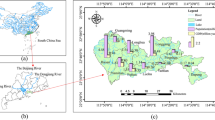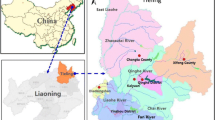Abstract
System dynamics (SD) have been used in water resources management for many years. However, water resources management using SD is usually in one direction, up to down or down to up, and does not consider internal and external system feedbacks, which may mislead managers and reduce the adaptability of water resources systems. Therefore, dynamic management of a water resources-socioeconomic-environmental (WSE) system based on feedbacks was established in this paper using SD, and a feedback function considering different intensities of feedbacks was proposed. The Beijing-Tianjin-Hebei region (BTHR), China, was chosen as the study area. Three subsystems were included in the WSE system: a socioeconomic subsystem, a water resources subsystem, and an environmental subsystem. We established and compared different dynamic management scenarios with various intensities of feedbacks. The results show that the shortage of water resources and pollution in the BTHR will continue to deteriorate from 2015 to 2030 if no management measures are taken, and the government should direct more attention to reducing the water demand of primary industry and population growth. In addition, we found that the three subsystems in the WSE system influence each other and evolve mutually. In particular, the influence of the water resources subsystem on the environmental subsystem is remarkable and cannot be ignored. This paper may act as a guide for adaptive and multi-objective management of WSE systems.




Similar content being viewed by others
References
Afzal J, Noble DH, Weatherhead EK (1992) Optimization Model for Alternative Use of Different Quality Irrigation Waters. J Irrig Drain Eng 118(118):218–228
Bai X, Imura H (2010) Towards Sustainable Urban Water Resource Management: A Case Study in Tianjin, China. Sustain Dev 9(1):24–35
Bazilian M et al (2011) Considering the Energy, Water and Food Nexus: Towards an Integrated Modelling Approach. Energy Policy 39(12):7896–7906
Charlton MB, Arnell NW (2011) Adapting to Climate Change Impacts on Water Resources in England—an Assessment of Draft Water Resources Management Plans. Glob Environ Chang 21(1):238–248
Chen Z, Wei S (2014) Application of System Dynamics to Water Security Research. Water Resour Manag 28(2):287–300
Connell-Buck CR, Medellín-Azuara J, Lund JR, Madani K (2011) Adapting California’s Water System to Warm Vs. Dry Climates. Clim Chang 109(1):133–149
Cruz JB, Tan RR, Culaba AB, Ballacillo J-A (2009) A Dynamic Input–Output Model for Nascent Bioenergy Supply Chains. Appl Energy 86:S86–S94. https://doi.org/10.1016/j.apenergy.2009.04.007
Ganji A, Khalili D, Karamouz M (2007) Development of Stochastic Dynamic Nash Game Model for Reservoir Operation. I. The Symmetric Stochastic Model with Perfect Information. Adv Water Resour 30(3):528–542
Gohari A, Eslamian S, Abedi-Koupaei J, Massah Bavani A, Wang D, Madani K (2013) Climate Change Impacts on Crop Production in Iran's Zayandeh-Rud River Basin. Sci Total Environ 442:405–419. https://doi.org/10.1016/j.scitotenv.2012.10.029
Gohari A, Mirchi A, Madani K (2017) System Dynamics Evaluation of Climate Change Adaptation Strategies for Water Resources Management in Central Iran. Water Resour Manag 31(5):1413–1434. https://doi.org/10.1007/s11269-017-1575-z
Guégan M, Uvo CB, Madani K (2012) Developing a Module for Estimating Climate Warming Effects on Hydropower Pricing in California. Energy Policy 42(2):261–271
Haasnoot M, Kwakkel JH, Walker WE, ter Maat J (2013) Dynamic Adaptive Policy Pathways: A Method for Crafting Robust Decisions for a Deeply Uncertain World. Glob Environ Chang 23(2):485–498. https://doi.org/10.1016/j.gloenvcha.2012.12.006
Hao Z, Aghakouchak A, Phillips TJ (2013) Changes in Concurrent Monthly Precipitation and Temperature Extremes. Environ Res Lett 8(3):1402–1416
Kepeng F, Juncang T (2013) Complex Adaptive System on Water Resources Allocation System. J Appl Sci 13(9):1530–1536
Kindler J (2000) Integrated Water Resources Management: The Meanders. Water Int 25(2):312–319. https://doi.org/10.1080/02508060008686833
Kotir JH, Smith C, Brown G, Marshall N, Johnstone R (2016) A System Dynamics Simulation Model for Sustainable Water Resources Management and Agricultural Development in the Volta River Basin, Ghana. Sci Total Environ 573:444–457
Leontief W (1986) Input–Output Economics, 2nd edn. Oxford University Press, New York
Lopez A, Fai F, New M, Watts G, Weston A, Wilby RL (2009) From Climate Model Ensembles to Climate Change Impacts and Adaptation: A Case Study of Water Resource Management in the Southwest of England. Water Resour Res 45(8):2263–2289
Ludwig F, Slobbe EV, Cofino W (2014) Climate Change Adaptation and Integrated Water Resource Management in the Water Sector. J Hydrol 518(2):235–242
Maani KE, Cavana RY (2007) Systems Thinking, System Dynamics: Managing Change and Complexity, 2nd edn. Prentice Hall, Auckland
Madani K (2010) Game Theory and Water Resources. J Hydrol 381(3):225–238
Mcmillan H et al (2017) How Uncertainty Analysis of Streamflow Data Can Reduce Costs and Promote Robust Decisions in Water Management Applications. Water Resour Res 53:5220–5228. https://doi.org/10.1002/2016WR020328
Mianabadi H, Mostert E, Zarghami M, Giesen NVD (2014) A New Bankruptcy Method for Conflict Resolution in Water Resources Allocation. J Environ Manag 144:152–159
Milly PCD, Betancourt J, Falkenmark M, Hirsch RM, Kundzewicz ZW, Lettenmaier DP, Stouffer RJ (2008) Climate Change - Stationarity Is Dead: Whither Water Management? Science 319(5863):573–574
Milly PCD et al (2015) On Critiques of "Stationarity Is Dead: Whither Water Management?". Water Resour Res 51(9):7785–7789
Niazi A, Prasher SO, Adamowski J, Gleeson T (2014) A System Dynamics Model to Conserve Arid Region Water Resources through Aquifer Storage and Recovery in Conjunction with a Dam. Water 6(8):2300–2321
Ostrom E (2009) A General Framework for Analyzing Sustainability of Social-Ecological Systems. Science 325(5939):419–422
Palmer MA, Lettenmaier DP, Poff LR, Postel SL, Richter B, Warner R (2009) Climate Change and River Ecosystems: Protection and Adaptation Options. Environ Manag 44(6):1053–1068
Parrachino I, Dinar A, Patrone F (2010) Cooperative Game Theory and Its Application to Natural, Environmental, and Water Resource Issues: 3. Application to Water Resources. Policy Research Working Paper 33(11):1–46
Peng S, Gao X (2012) Discussion on improvement on irrigated water use coefficient (in Chinese). China Water Resources: 33–35
Pisarevsky AM, Polozova IP, Hockridge PM (2005) Chemical Oxygen Demand. Russ J Appl Chem 78(1):101–107. https://doi.org/10.1007/s11167-005-0239-6
Prein AF, Holland GJ, Rasmussen RM, Clark MP, Tye MR (2016) Running Dry: The U.S. Southwest's Drift into a Drier Climate State. Geophys Res Lett 43(3):1272–1279
Rodriguez-Ulloa R, Paucar-Caceres A (2005) Soft System Dynamics Methodology (Ssdm): Combining Soft Systems Methodology (Ssm) and System Dynamics (Sd). Syst Pract Action Res 18(3):303–334
Roozbahani R, Schreider S, Abbasi B (2015) Optimal Water Allocation through a Multi-Objective Compromise between Environmental, Social, and Economic Preferences. Environ Model Softw 64(64):18–30
Song XM, Kong FZ, Zhan CS (2011) Assessment of Water Resources Carrying Capacity in Tianjin City of China. Water Resour Manag 25(3):857–873
Sowers J, Vengosh A, Weinthal E (2011) Climate Change, Water Resources, and the Politics of Adaptation in the Middle East and North Africa. Clim Chang 104(3–4):599–627
Sun Y, Liu N, Shang J, Zhang J (2016) Sustainable Utilization of Water Resources in China: A System Dynamics Model. J Clean Prod 142:613–625
Villarroel WR, Beck MB, Hall JW, Dawson RJ, Heidrich O (2014) The Energy-Water-Food Nexus: Strategic Analysis of Technologies for Transforming the Urban Metabolism. J Environ Manag 141(1):104–115
Vincenot CE, Giannino F, Rietkerk M, Moriya K, Mazzoleni S (2011) Theoretical Considerations on the Combined Use of System Dynamics and Individual-Based Modeling in Ecology. Ecol Model 222(1):210–218
Walsh CL et al (2016) Adaptation of Water Resource Systems to an Uncertain Future. Hydrol Earth Syst Sci 20(5):1869–1884
Wang G, Mang S, Cai H, Liu S, Zhang Z, Wang L, Innes JL (2016) Integrated Watershed Management: Evolution, Development and Emerging Trends. J For Res 27(5):967–994. https://doi.org/10.1007/s11676-016-0293-3
Xuan W, Quan C, Li S (2012) An Optimal Water Allocation Model Based on Water Resources Security Assessment and Its Application in Zhangjiakou Region, Northern China. Resour Conserv Recycl 69(12):57–65
Yang J, Lei K, Khu S, Meng W (2015) Assessment of Water Resources Carrying Capacity for Sustainable Development Based on a System Dynamics Model: A Case Study of Tieling City, China. Water Resour Manag 29(3):885–899
Zeff HB, Herman JD, Reed PM, Characklis GW (2016) Cooperative Drought Adaptation: Integrating Infrastructure Development, Conservation, and Water Transfers into Adaptive Policy Pathways. Water Resour Res 52(9):7327–7346. https://doi.org/10.1002/2016WR018771
Zeng Z, Liu J, Koeneman PH, Zarate E, Hoekstra AY (2012) Assessing Water Footprint at River Basin Level: A Case Study for the Heihe River Basin in Northwest China. Hydrol Earth Syst Sci 16(8):2771–2781
Zhang JY, Wang LC (2015) Assessment of Water Resource Security in Chongqing City of China: What Has Been Done and What Remains to Be Done? Nat Hazards 75(3):2751–2772
Zhou H, Hui P, Chi Z, Xiao J (2007) Optimization and Evaluation of Multi-Objective Crop Pattern Based on Irrigation Water Resources Allocation. Transactions of the Chinese Society of Agricultural Engineering 167(3):229–235
Zhou Y, Guo S, Xu C-Y, Liu D, Chen L, Ye Y (2015) Integrated Optimal Allocation Model for Complex Adaptive System of Water Resources Management (I): Methodologies. J Hydrol 531:964–976
Acknowledgements
This research is financially supported by the National Key R&D Program of China (Grant No. 2016YFC0401309), the National Nature Science Foundation of China (Grant Nos. 51439007, 91647119), the Humanities and Social Sciences Fund of the Ministry of Education in China (Grant No.18YJCZH016) and the Innovation group of the Hubei Natural Science Foundation (Grant No.2017CFA015).
Author information
Authors and Affiliations
Corresponding author
Ethics declarations
Conflict of Interest
None.
Additional information
Publisher’s Note
Springer Nature remains neutral with regard to jurisdictional claims in published maps and institutional affiliations.
Electronic supplementary material
ESM 1
(PDF 293 kb)
Rights and permissions
About this article
Cite this article
Dong, Q., Zhang, X., Chen, Y. et al. Dynamic Management of a Water Resources-Socioeconomic-Environmental System Based on Feedbacks Using System Dynamics. Water Resour Manage 33, 2093–2108 (2019). https://doi.org/10.1007/s11269-019-02233-8
Received:
Accepted:
Published:
Issue Date:
DOI: https://doi.org/10.1007/s11269-019-02233-8




